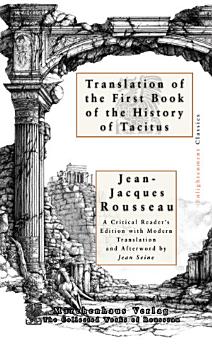Translation of the first Book of the History of Tacitus
About this ebook
Rousseau worked on this translation around the mid-1750s and left it incomplete. He never published it himself; indeed, he referred to it dismissively as “only a student’s exercise” once he showed it to others. After his death the manuscript was finally printed in 1782, appearing in Geneva as part of the Mélanges (Volume 7) of his collected works. Only the first book of Tacitus’s Histories (covering the chaotic Year of the Four Emperors) is rendered, and even that is abridged. Rousseau includes a preface in which he explains that he understood Latin only poorly, so he focused on capturing Tacitus’s austere style rather than following every word. In his own words he did “not seek to render Tacitus’s phrases, but his style”. He quickly abandoned the project after a few chapters, but not before noting that the task was beyond him and that he was giving readers only a preliminary sample. The text as printed ends without having covered all of Book I, and there is no second book translation.
Today this translation is mainly of interest to Rousseau scholars. It was one of his last forays into historical writing. That said, it provides insight into his stylistic ambitions. Rousseau was always concerned with the power of language, and here he challenges himself on a difficult Latin source. Historians of Rousseau often point to this fragment to show how he valued the clarity and directness of Tacitus – qualities Rousseau admired – and how he struggled to bring them into French. As a published work, it mattered little in the 18th century, but for modern readers it enriches our picture of Rousseau as a lifelong autodidact. It reminds us that even at the end of his career he was experimenting with different genres. In sum, Traduction du premier Livre de l’histoire de Tacite is a minor but revealing piece, testifying to Rousseau’s broad literary interests and his personal quest to master prose.











